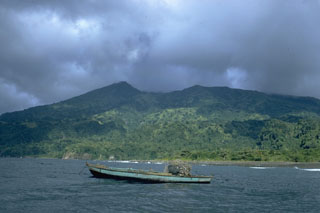Report on Soufriere St. Vincent (Saint Vincent and the Grenadines) — July 1979
Scientific Event Alert Network Bulletin, vol. 4, no. 7 (July 1979)
Managing Editor: David Squires.
Soufriere St. Vincent (Saint Vincent and the Grenadines) Lava extrusion continues
Please cite this report as:
Global Volcanism Program, 1979. Report on Soufriere St. Vincent (Saint Vincent and the Grenadines) (Squires, D., ed.). Scientific Event Alert Network Bulletin, 4:7. Smithsonian Institution. https://doi.org/10.5479/si.GVP.SEAN197907-360150
Soufriere St. Vincent
Saint Vincent and the Grenadines
13.33°N, 61.18°W; summit elev. 1220 m
All times are local (unless otherwise noted)
Lava extrusion at Soufrière continued through July. Between surveys on 2 July and 4 August, the lava had expanded 30-50 m horizontally (except on the N side where it had reached the crater wall, 4:6) and about 6 m vertically, to a mean diameter of 820 m and a mean height of 85 m. Assuming 45° sides, its volume was 36.5 x 106 m3 on 4 August, having increased an average of 0.36 x 106 m3/day in July (similar to the June rate).
During the August survey, some pulsing steam emission took place, mostly at the S edge of the lava, but no explosions were observed. The summit seismic station recorded 50-200 small earthquakes per day during July, but none of these were detected by instruments on the flanks.
Geological Summary. Soufrière St. Vincent is the northernmost and youngest volcano on St. Vincent Island. The NE rim of the 1.6-km wide summit crater is cut by a crater formed in 1812. The crater itself lies on the SW margin of a larger 2.2-km-wide caldera, which is breached widely to the SW as a result of slope failure. Frequent explosive eruptions after about 4,300 years ago produced pyroclastic deposits of the Yellow Tephra Formation, which cover much of the island. The first historical eruption took place in 1718; it and the 1812 eruption produced major explosions. Much of the northern end of the island was devastated by a major eruption in 1902 that coincided with the catastrophic Mont Pelée eruption on Martinique. A lava dome was emplaced in the summit crater in 1971 during a strictly effusive eruption, forming an island within a lake that filled the crater. A series of explosive eruptions in 1979 destroyed the 1971 dome and ejected the lake; a new dome was then built.
Information Contacts: J. Tomblin, UWI.

